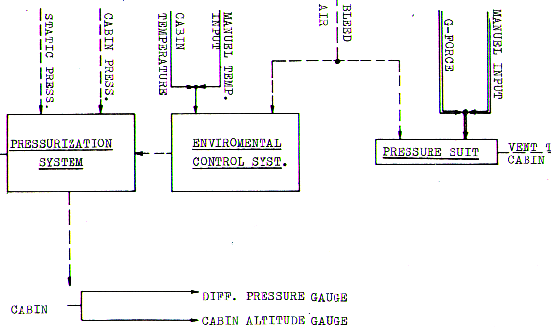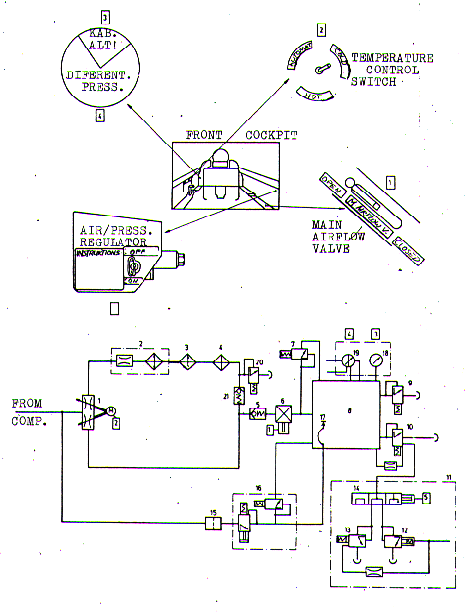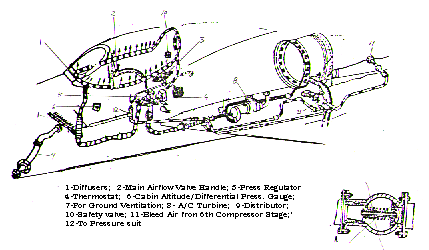
MiG-21 Cabin Pressurization System
The described cabin pressurization system is the one of the MiG-21US (Type 68, NATO Mongol B). However, it is very similar to the one used in
MiG-21PF, MF, BIS. I'll add the missing schematic at a later time.
For the sake of simplicity, the cabin pressurization system
is divided into two subsystems, namely the environmental
control system and the actual cabin pressurization.
Environmental Control System
 Cabin air temperature is regulated by a three-way switch
which is labelled "Hot, Cold and Automatic". This switch is
directly linked to the main air distributor (1).In the
automatic mode, air temperature is regulated to a preset
value. This cannot be accomplished by the pilot, it must be
preset by ground personal. Should the pilot wish to reduce cabin temperature manually,
he has two choices - hot or cold. Should the temperature
become uncomfortable, he can select either "Cold" or "Hot"
resulting in either hot or cold air entering the cabin. Once
the desired temperature has reached, he must switch back to
the original position. It should be noted that, due to limitations of the
distributor flap motor, the pilot must expect a lag of 30
seconds before airflow temperature reverses which requires
some pre-planning. In addition, it is advisable that, should
a descent be commenced in certain meteorological condition,
the pilot should switch to the hot setting to prevent ice
formation on the outside of the canopy and condensation on
the inside of the canopy.
Cabin air temperature is regulated by a three-way switch
which is labelled "Hot, Cold and Automatic". This switch is
directly linked to the main air distributor (1).In the
automatic mode, air temperature is regulated to a preset
value. This cannot be accomplished by the pilot, it must be
preset by ground personal. Should the pilot wish to reduce cabin temperature manually,
he has two choices - hot or cold. Should the temperature
become uncomfortable, he can select either "Cold" or "Hot"
resulting in either hot or cold air entering the cabin. Once
the desired temperature has reached, he must switch back to
the original position. It should be noted that, due to limitations of the
distributor flap motor, the pilot must expect a lag of 30
seconds before airflow temperature reverses which requires
some pre-planning. In addition, it is advisable that, should
a descent be commenced in certain meteorological condition,
the pilot should switch to the hot setting to prevent ice
formation on the outside of the canopy and condensation on
the inside of the canopy.

Pressurization System
In order to pressurize the cabin, air is bled from the
number 6 compressor stage at 350 degrees C which is then channelled
to the distributor (1) where it is separated. Hot air is
channelled directly to the cabin via check valve (5) and
main airflow valve (6) whereas air that is used for cooling,
is bled to two heat exchangers (2,3). Once the air is initially cooled, further cooling is
accomplished by an air conditioning turbine (4) which,
essentially, is a compressor. The cool air is then
channelled via check valves (21 and 9) to main airflow valve
(6). It should be noted that, regardless of the main airflow
valves position, air is always bled from the engine and
cooled for the purpose of pressurization. The main valve, in
closed position, merely inhibits pressurized air from
reaching the cabin. The amount of pressure differential is governed by outflow
valve (10) in conjunction with the chamber for constant
differential pressure (13) and the aneroid chamber for
increasing differential pressure (12). This system ensures a
constant differential pressure of 220 Torr or 0.31 bar. The safety valve (9) will open if differential pressure
rises to 0.34 bar. It should be noted that cabin pressure remains the same as
ambient pressure up to 6000 ft, after which cabin pressure
decreases in direct ratio with altitude maintaining the
afore mentioned cabin pressure differential (0.31 bar; see
diagram). Air used for the G-pants is bled directly from the
compressor section and channelled to a paper filter (15) and
thence to pressure regulator (16). The regulator senses
G-loads imposed on the pilot and thereby regulates air flow
to the G-pants which is then distributed via coupler
(17). Excess air is bled directly to the cabin. Numerous safety devices are built into the system to ensure
proper operation. These are safety valve (20) which opens,
should the preset pressure valve from the A/C turbine exceed
0.9 +/- 0.1 bar, and pressure limiter (7) which is activated,
should pressure deviate by more then 0.12 bar. The cabin
safety valve is set to 0.34 bar. A ground check valve (14) is incorporated into the system,
should ground tests of the pressurization system become
necessary.
 EMERGENCY PROCEDURES
EMERGENCY PROCEDURES
a) Smoke in cabin.
1. 100% oxygen
2. Main airflow valve - closed.
3. Descent below 36000 ft
Note: In extreme cases canopy may be jettisoned.
Warning: Do not open canopy in flight!
b) Inflight depressurization
Symptoms: Ear pain and rapidly rising cabin altitude; decreasing differential pressure at UWP-20; above 36000 ft -
pilot will note pressure build up in Oxygen-mask and presssure
suit; water vapor will form in cabin.
1. Descent below 36000 ft
2. Check Oxygen-consumtion and quantity
3. Oxygen-pressure below 30 bar - descent below 12000 ft












 Cabin air temperature is regulated by a three-way switch
which is labelled "Hot, Cold and Automatic". This switch is
directly linked to the main air distributor (1).In the
automatic mode, air temperature is regulated to a preset
value. This cannot be accomplished by the pilot, it must be
preset by ground personal. Should the pilot wish to reduce cabin temperature manually,
he has two choices - hot or cold. Should the temperature
become uncomfortable, he can select either "Cold" or "Hot"
resulting in either hot or cold air entering the cabin. Once
the desired temperature has reached, he must switch back to
the original position. It should be noted that, due to limitations of the
distributor flap motor, the pilot must expect a lag of 30
seconds before airflow temperature reverses which requires
some pre-planning. In addition, it is advisable that, should
a descent be commenced in certain meteorological condition,
the pilot should switch to the hot setting to prevent ice
formation on the outside of the canopy and condensation on
the inside of the canopy.
Cabin air temperature is regulated by a three-way switch
which is labelled "Hot, Cold and Automatic". This switch is
directly linked to the main air distributor (1).In the
automatic mode, air temperature is regulated to a preset
value. This cannot be accomplished by the pilot, it must be
preset by ground personal. Should the pilot wish to reduce cabin temperature manually,
he has two choices - hot or cold. Should the temperature
become uncomfortable, he can select either "Cold" or "Hot"
resulting in either hot or cold air entering the cabin. Once
the desired temperature has reached, he must switch back to
the original position. It should be noted that, due to limitations of the
distributor flap motor, the pilot must expect a lag of 30
seconds before airflow temperature reverses which requires
some pre-planning. In addition, it is advisable that, should
a descent be commenced in certain meteorological condition,
the pilot should switch to the hot setting to prevent ice
formation on the outside of the canopy and condensation on
the inside of the canopy.
 EMERGENCY PROCEDURES
EMERGENCY PROCEDURES